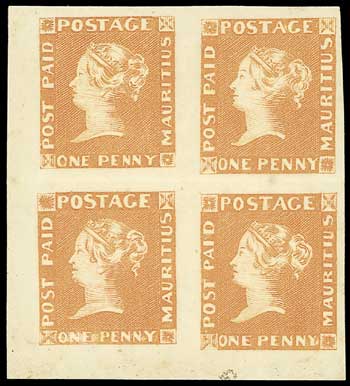
Auction: 7015 - Important Stamps and Covers of the World
Lot: 1064
Mauritius 1848 (June) "post paid" Following the success of the "Post Office" Mauritius stamps which were sold out shortly after their being placed on sale in September, 1847, the Colonial Agent ordered a supply of 100,000 Britannia-design stamps from Perkins, Bacon & Co. in London. Once again, the delay in supplying the stamps led to the new issue being produced locally. As the single impression plates of the "Post Office" stamps were deemed to make the printing of the requisite quantity of stamps too laborious, Joseph Barnard was commissioned to engrave new plates for a One Penny and a Two Pence value. Nevertheless, there was some delay in their preparation due to medical treatment Barnard was receiving for failing eyesight. The design of the new issue closely resembled that of the first issue, the major difference being the words "post paid" instead of "post office" on the left side. One plate of each value containing twelve impressions was engraved on the back of copper plates previously used for printing advertisements for the Grand Hotel d´Europe in Port Louis. Since each impression was engraved separately, the stamps can be plated very easily. The seventh stamp in the plate of the 2d. value had an "o" instead of "c" engraved in "pence", thus resulting in the famous "penoe" error. The plates were in use for approximately ten years. Due to the softness of the copper, the plates became progressively worn, resulting in a remarkable array of contrasting impressions. Philatelists recognise five distinct states of the plates ranging from the elusive earliest impressions, which demonstrate the deepness of the engraving, to the almost unrecognisable latest impressions. Hiroyuki Kanai has discovered a sixth state of the 2d., which is a retouched impression, before the plate was re-engraved by Robert Sherwin in 1859. Earliest Impression on thick yellowish paper 1d. orange-vermilion, the stupendous block of four from the lower left corner of the sheet with some traces of original gum.
The stamps are of a beautifully sharp proof-like impressions exemplificative of the earliest impression, and the colour is rich, vivid and of post office freshness. The block has large to enormous margins. There is a horizontal crease in the margin between the stamps and a vertical crease crosses the two right-hand stamps, neither of which significantly affects the superb overall appearance. Despite a few spots of tropicalisation on the reverse which are barely discernible from the front, this block is in a remarkable state of preservation.
Sold for
£300,000




